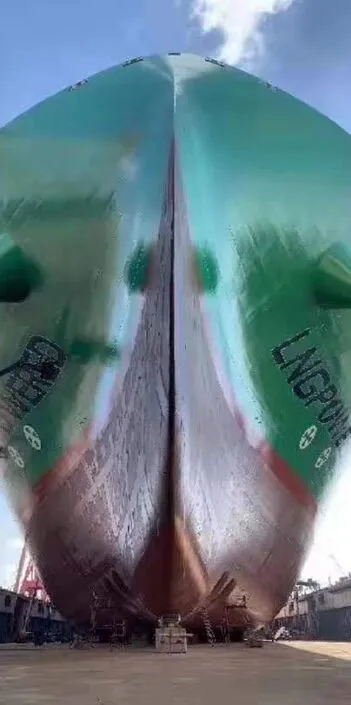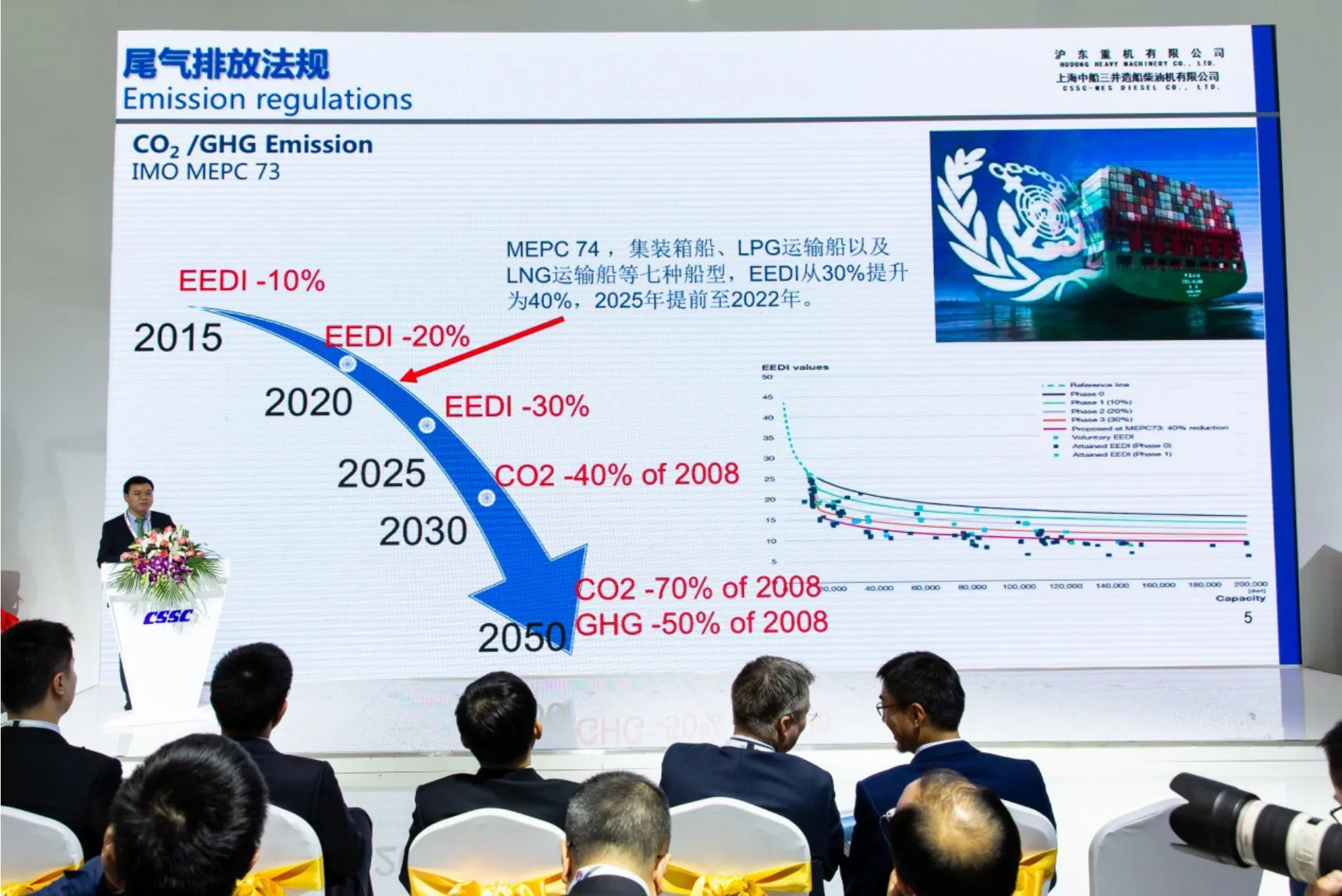Domestic Engine Market Share up, Import Impact Remains Huge
——Analysis on the Development Situation of China Marine Low Speed Engine Manufacturing Industry
Zhang Qi and Zheng Yiming, from CANSI
Marine low-speed engine is the"heart" of large ocean-going ships,which holds an important position in the shipbuilding industry value chain and marine equipment sector. It is of great significance to enhance the industrial competitiveness of marine low-speed engine to the shipbuilding industry. In recent years,China has made positive progress in the research and development of marine lowspeed engines, brand building and market development, but compared with Japan and Korea, the domestic market share of China's main engine manufacturers and the ability to open up overseas markets still have a lot of room to improve.
In order to fully understand and correctly understand the market position and existing problems of marine low speed engine manufacturing industry in China, the China Association of the National Shipbuilding Industry (CANSI)has recently sorted out the installation of ocean-going ship low speed engines delivered globally from 2010 to 2018. The main engine delivery data are counted as per the year in which the ship delivery date is located, and the market share is calculated according to the power unit.The main conclusions are as follows.
Global Marine Low-Speed Engines Mounted on Board on the Decline
Affected by the continued downturn in the newbuilding market, global marine low-speed engine production and engines mounted on board continued to decline,of which 1802 units/37.68 million horsepower and 851 unit/16.63 million horsepower were delivered in 2010 and 2018, respectively, and the market scale shrank by more than 50% in eight years, which had a great impact on major marine low-speed engine licensers and manufacturers.
The delivery quantity of low-speed engine manufacturers of China, Japan and Korea has shrunk, among which, the quantity of delivery in Korea was reduced from 895 units/22.19 million kilowatts in 2010 to 251 units/6.55 million kilowatts in 2018, down by about 70%; and the quantity of delivery in Japan was reduced from 569 units/9.01 million kilowatts in 2010 to 330 units/5.04 million kilowatts in 2018, down by more than 40%; China's low-speed engine delivery increased from 282 units/5.54 million kW in 2010 to 428 units/5.99 million kilowatts in 2012, and fell to 263 units/4.91 million kW in 2018.

WinGD Global Share Begins to Pick up
MAN ES, WinGD/Wartsila and Mitsubishi Heavy Industries (MHI) are the world's leading marine low-speed engine licensers, with MAN ES having a market share of more than 80% for a long time. WinGD's global share has been recovering as a whole since 2016,reaching 16.3% in 2018, leaving a large gap with MAN ES. In addition, MHI’s global share of low-speed engines has been below 3% for a long time, compared with 2.3% in 2018.
On market areas, the market share of WinGD/Wartsila low speed engines in China has experienced some fluctuations,but after the acquisition of Wartsila by CSSC in 2014, the market share of WinGD has shown a rising trend and is now approaching 15%. WinGD market share in Korea has been rising rapidly since 2016, with obvious advantages of its dual fuel low speed engine in the Korean market. In the Japanese market, the share of WinGD is basically less than 10%,mainly due to the support of Japanese shipyards for MHI, the local low-speed engine brand, and fairly close technical cooperation between Japan and MAN ES.By contrast, Korean shipyards rarely use MHI's marine low-speed engines.
Chinese Low-Speed Engine Market Share Steadily Increases
With the improvement of the manufacturing capacity of China's lowspeed engines and the increasing strength of the domestic market development,although the global marine low speed engine market scale has been shrinking,the global market share of the Chinese manufacturers has steadily improved, and the global market competition pattern has changed significantly. The market share gap of China, Japan and Korea's global low-speed engines has gradually narrowed and developed into the Big Three. In 2010, the market share of lowspeed engine manufacturers in Korea,Japan and China was 58.9%, 23.9% and 14.7%, respectively; in 2018, the share of China and Japan both rose to around 30%,while that of Korea declined to 39.4%.
In addition, CANSI and MAN ES signed the Memorandum of Understanding in 2011, and it is agreed that the MAN ES brand marine low-speed engines manufactured by main engine manufacturers in other countries than China shall get the consent of CANSI.The MOU greatly reduces the influence of foreign main engine manufacturers on the Chinese market, and is beneficial to the promotion of the market share of Chinese manufacturers.
On manufacturer performance,compared with 2010 ~ 2015, the rising global market share and ranking of Chinese marine low speed engine manufacturers from 2016 to 2018 are obvious. HHM, Shanghai Zhongchuan Mitsui Shipbuilding Diesel Engine Co., Ltd., Dalian Marine Diesel Engine Co., Ltd., and Yichang Marine Diesel Engine Co., Ltd., the four major Chinese manufacturers have all increased their global market share. The combined share of all low-speed engine manufacturers under CSSC rose from 14.9% in 2010-2015 to 25.8% in 2016-2018, surpassing the HSD engine (formerly Korean Doosan Engine), and approaching the global share of Hyundai Heavy Industries in Korea.

China Market Considerably Occupied by Korea
From 2010 to 2018, Chinese shipyards imported a total of 2187 units/40.73 million horsepower marine low-speed engines, including 1730 units/33 million horsepower from Korea and 334 units/5.32 million horsepower from Japan. Among them, Korean manufacturers exported 384 units/6.13 million horsepower marine low-speed engines to Chinese shipyards in 2010 alone, accounting for 46.6% of the Chinese market. In nine years, HHI, STX Engine and Doosan Engine all shipped more than 500 units to Chinese shipyards.
With the continuous development of China's marine low-speed engine manufacturing industry and the joint efforts of all parties in the industrial chain,the domestic market share of China's marine low-speed engines has increased from 42.1% in 2010 to 76.2% in 2017,leaving a big gap with Japan and Korea.Korean and Japanese shipyards rarely use the products of foreign low-speed engine manufacturers. The market share of Korean main engine manufacturers for domestic marine low-speed engines has maintained at more than 97% for a long time, and even reached 100% in a few years, while the market share of Japanese main engine manufacturers for domestic marine low-speed engines has maintained at more than 99% for a long time.
Worryingly, the increase in the domestic market share of China's marine low-speed engines has basically stagnated in the past three years. In 2018,the domestic supply share of China's marine low-speed engine market was basically maintained at about 75%, and even decreased in 2018 compared with 2017. In the past three years, Chinese shipyards imported 286 units/5.58 million horsepower low-speed engines, of which 204 units were imported from Korea and 58 from Japan. Most of them were models that Chinese main engine manufacturers can produce, of which nearly 50 imported low-speed engines were installed on ocean-going ships ordered by Chinese shipowners in Chinese shipyards.

Export Almost Void
In order to meet the demand for orders from huge capacity, Korean and Japanese marine low-speed engine manufacturers are trying to open up markets outside their own country, the overseas market tapped by Korea once accounted for nearly 40% of Korea's low-speed engine production. In recent years, with the continuous development of local manufacturers in China, the share of Korea and Japan in the Chinese market has declined significantly,but marketing efforts have continued unabated. At present, Korea exports about 100 units/2.5 million horsepower of marine low speed engines annually, with China as its top market, followed by the Philippines and Vietnam. Japan exports 45 units/700000 horsepower of low speed engines annually, mainly to China and the Philippines。
China has exported only 9 units/140,000 horsepower marine lowspeed engines since 2010, with dispersed export destinations, while the imports amounted to 2187 units/40.73 million horsepower during the same period, and the situation is in urgent need of change under the condition that the current domestic main engine manufacturers’orders are insufficient.
For proposals on the development of China's low-speed engine manufacturing industry, the first is Chinese marine low-speed engine manufacturers should strengthen communication with general assembly plants, continuously improve the product quality, tap into the domestic market, actively explore the Southeast Asian market, and introduce the products to small and mediumsized shipyards in Japan and Korea.The second is that China's shipyards and shipowners should more consider products of Chinese main engine manufacturers and strengthen the collaboration of the industrial chain.Thirdly, WinGD should continue to strengthen its R&D and marketing,maintain and expand its competitive advantage in the dual-fuel engine model,seize the historical opportunity of power change of global ocean-going vessels.

- 船舶经济贸易的其它文章
- 运输市场呈“V”形走势2019年11月中国沿海(散货)运输市场分析
- Seize Opportunity to Open up a New Journey of High Quality Development
- Keys to Continuous Profitability of Two Shipbuilders Amidst Downturn Market Explored
- Build World Leading Professional Maritime Expo
——An Interview with Xing Wenhua, Chairman of the Chinese Organizing Committee of Marintec China 2019 and Chairman of the Shanghai Society of Naval Architects and Marine Engineers (SSNAME) - 基本面有所改善市场运价上涨2019年11月中国出口集装箱运输市场分析
- 大船止跌反弹中小船涨跌互现2019年11月世界油货运输市场分析

